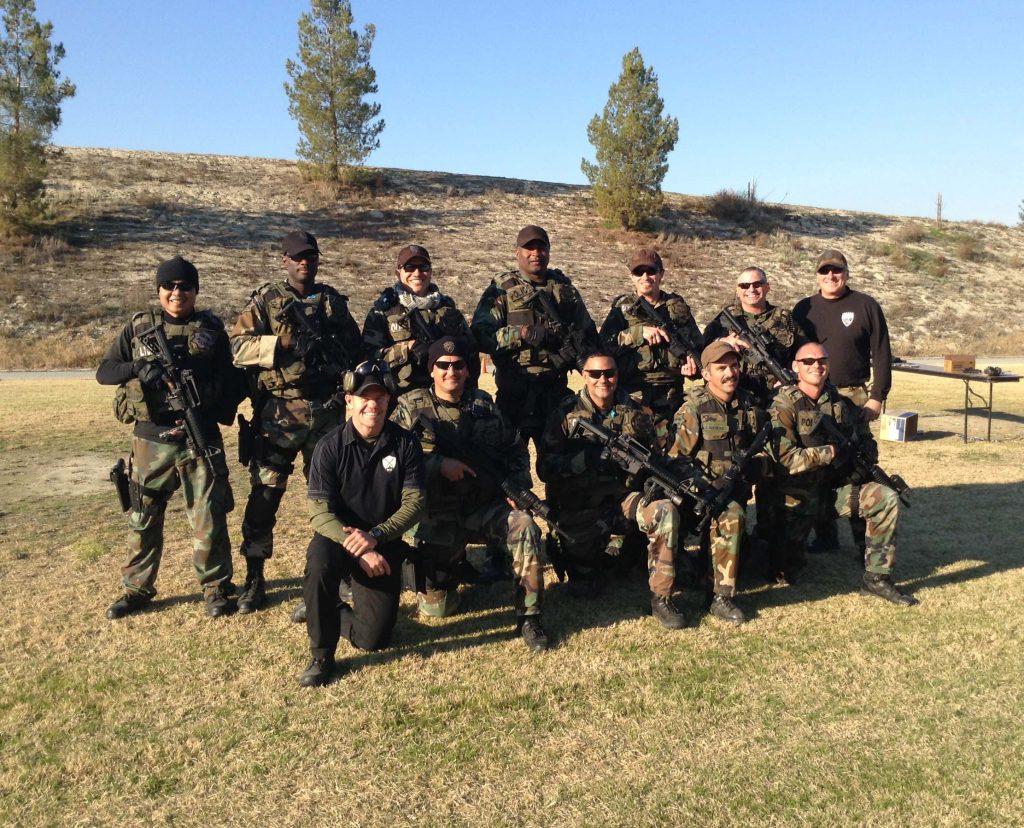
Adam Scott and Rob Shaul
SUMMARY
PURPOSE: The purpose of this study was to assess the effect of trigger pull resistance on non-stressed and stressed tactical marksmanship at three distances: 15 yards, 50 yards, and 100 yards.
SUBJECTS: Ten experienced, part-time members of a medium-sized city (Fresno, CA) SWAT team (ages 32-45) participated in the study.
DESIGN: Athletes were randomly divided into 2 groups. Group 1 (G1) used stock triggers during two sets of marksmanship trials. Group 2 (G2) used stock triggers during the initial trial, then switched to a new, lighter-resistance Hiperfire brand “Hipertouch EDT2” trigger for the second trial (TABLE 1).
TABLE 1: Study Groups and Triggers

The study compared differences in group performances at the three study distances: 15, 50 and 100 yards (FIGURE 1).
FIGURE 1: STUDY DESIGN AND SET-UP

RESULTS: The Stock Trigger Group performed better in 15-yard non-stressed, 15-yard stressed and 100-yard non-stressed marksmanship.
The Light Trigger Group performed better Stock in 50-yard non-stressed, 50-yard stressed and 100-yard stressed marksmanship.
TABLE 2: Trigger Pull Group Performance during Trial 2
(X = Better Marksmanship Improvement)

DISCUSSION
Trigger control is a fundamental determinate of accurate marksmanship. Flinching or jerking in anticipation of recoil, slapping the trigger instead of squeezing, or trying to “ambush” the bullseye during the natural sight picture weave are common causes of missed shots. A lighter trigger, in theory, decreases the time the marksman spends squeezing the trigger, and can more often result in the wanted “surprise,” accurate shot. Light triggers are favored by competitive marksman as well as many tactical (military and LE) snipers for these reasons.
Stock M4 triggers have a pull weight of 7.5-9.5 pounds. Prior to the study, we hypothesized that the lighter triggers would improve marksmanship performance and that this effect would increase as distances increased.
Although our results were not statistically significant (due to large individual variation and a small sample size), our results seem to hint at possible support for the hypothesis.
The Lighter Trigger Group showed superior performance at both 50-yard measures and one of the 100-yard measures. However, since the Lighter Trigger Group failed to out-perform the Stock Trigger Group during 100-yard non-stressed shooting it is difficult to make any firm conclusions concerning the overall effect of the lighter triggers.
Anecdotally, the athletes in the light trigger group liked the lighter triggers. The lighter, single-stage Hiperfire triggers “took a step out of the trigger pull process,” commented one team member. The triggers were “lighter, smoother and had a good, surprise break,” said another.
However, two team members reported an unexpected second shot during the stress events. This could explain the decrease in the light trigger group marksmanship under stress at 100m and could be remedied by the athletes having more time to practice with the new, lighter, triggers.
RECOMMENDATIONS
Based on the findings from this initial study we believe that further research is needed to make conclusive determinations and recommendations. That notwithstanding, we offer the following suggestions:
- At a cost of less than $100 and an install time of fewer than 5 minutes, after-market, lighter-resistance triggers offer relatively low-cost options which may help improve marksmanship at distance greater than 15 yards.
- The large variation measured between individual marksmanship scores shows a need for increased marksmanship training. Like most units of similar size, this part-time SWAT team is given extremely limited training time (1-2 days per month). During this training time the team must meet all of it required quarterly and yearling training requirements – many of which are not marksmanship-related, such as communications, medical, tactics, etc. Simply recommending the team spend more time on the range doesn’t reflect the realities of their part-time status and other training requirements. Because of this, we recommend complementing limited range work with non-live fire methods of marksmanship practice including dry fire, airsoft, laser systems, and new non-lethal target bullet rounds as a way to train marksmanship without the travel time or expense of live firework at the range.
FURTHER RESEARCH
Based on the results of this study we hope to continue research. Specifically:
- Repeat this study with either a larger sample (20+ athletes) or with more consistent marksman. Wide variation between trials by individual marksman created enough “noise” in the data that it was not statistically significant.
- Several of the study subjects used iron sights on their weapons. We’d like to study the impact that red-dot optics may have on tactical marksmanship for similar athletes who don’t get frequent range time.
- Study impact non-range marksmanship training (dry-fire, airsoft, laser, etc.) on actual marksmanship. As well, test and develop specific training protocols and progressions using these methods which tactical athletes can deploy in their own training and with their teams.
- Study the effect of trigger pull resistance in handguns marksmanship.
- Study assess trigger pull weight safety issues and develop a mission-direct safety testing protocol to balance the potential marksmanship advantages of lighter triggers with the safety concerns of accidental discharge. A study of this nature could help produce nationally recognized guidelines for tactical assault rifles based on safety and accuracy.
Read full report: STUDY REPORT
Watch full video report:
Questions? Comments? Feedback? Email coach@mtntactical.com
